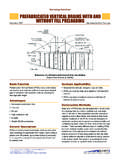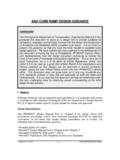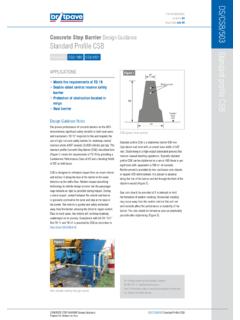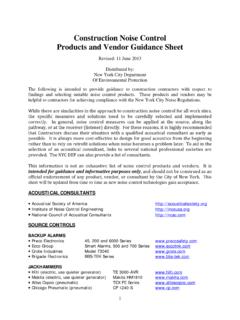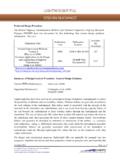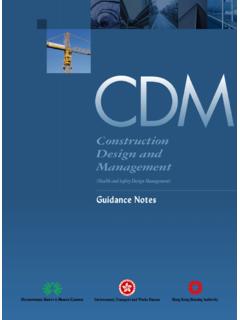Transcription of CONTINUOUS FLIGHT AUGER (CFA) PILES DESIGN …
1 CONTINUOUS FLIGHT AUGER (CFA) PILES November 2012 Page 1 of 10 G02 GEOTECHNICAL SOLUTIONS FOR SOIL IMPROVEMENT, RAPID EMBANKMENT CONSTRUCTION, AND STABILIZATION OF PAVEMENT WORKING PLATFORM DESIGN GUIDANCE Preferred DESIGN Procedure The Federal Highway Administration (FHWA) has a DESIGN document for this technology. The DESIGN document also contains information about construction techniques, quality control/quality assurance, and specifications. Chapter 6 of the document contains the complete DESIGN procedure. A summary of the procedure is presented following the reference table below. Publication Title Publication Year Publication Number Available for Download DESIGN and Construction of CONTINUOUS FLIGHT AUGER PILES 2007 Geotechnical Engineering Circular (GEC) No. 8 Yes1 1 Use of CFA PILES for Embankment Support If the CFA PILES will be used for embankment support, please see the DESIGN Guidance for column-supported embankments for recommended DESIGN procedures for the arching/load transfer mechanism from the embankment to the columns.
2 Summary of DESIGN /Analysis Procedure: FHWA Current FHWA Reference: Brown et al. (2007) This document is a state-of-the-practice manual for the DESIGN and construction of CONTINUOUS FLIGHT AUGER (CFA) PILES , including those PILES commonly referred to as augered cast-in-place (ACIP) PILES , drilled displacement (DD) PILES , and screw PILES . These names refer to types of drilled foundations in which the AUGER is drilled to the final depth and the pile is cast during AUGER withdrawal. In CFA PILES , the flights of the AUGER are filled with soil during drilling providing lateral support and maintaining the stability of the hole. At the same time the AUGER is withdrawn from the hole, concrete or a sand/cement grout is placed by pumping the concrete or grout mix through the hollow center of the AUGER pipe to the base of the AUGER .
3 Simultaneous pumping of the concrete or grout and withdrawing of the AUGER provides CONTINUOUS support of the hole. Reinforcement for steel-reinforced CFA PILES is placed into the hole filled with fluid concrete/grout immediately after withdrawal of the AUGER . CONTINUOUS FLIGHT AUGER (CFA) PILES November 2012 Page 2 of 10 G02 GEOTECHNICAL SOLUTIONS FOR SOIL IMPROVEMENT, RAPID EMBANKMENT CONSTRUCTION, AND STABILIZATION OF PAVEMENT WORKING PLATFORM DESIGN GUIDANCE Brown et al. (2007) presents a technology overview of CFA PILES , applications for transportation projects, construction techniques and materials, static capacity analysis, recommended DESIGN procedures, QC/QA procedures, and guide specifications. The DESIGN procedures follow the Allowable Stress DESIGN (ASD) format since strength reduction factors have not yet been calibrated for CFA PILES in an LRFD approach.
4 The DESIGN procedure contains the following steps: (1) Initial DESIGN considerations (2) Comparison and selection of deep foundation alternatives (3) Select pile dimensions and calculate performance under specified loads a. Calculation of single pile length and diameter based on axial capacity b. Verification of capacity and performance for both axial and lateral loads c. Verification of pile group capacity and group settlement calculations d. pile structural DESIGN e. Miscellaneous considerations (4) Constructability review (5) Prepare plans and specifications, set QC/QA and load test requirements Step (1) involves establishing the general structural foundation requirements for the intended application, site geology, and subsurface conditions. Step (2) involves comparison of deep foundation alternatives including driven PILES , drilled shafts, micropiles, and CFA PILES including conventional CFA PILES and DD PILES .
5 Table in Brown et al. (2007) contains a summary of deep foundation alternatives which are appropriate based on the soil conditions, type of soil profile, location of the ground water table, structural considerations, and other factors such as seismic considerations, scour, potential for contaminated spoils, construction over water, and economic factors. Step (3) involves checking the geotechnical ultimate limit state (GULS), service limit state (SLS), and structural ultimate limit state (SULS) of the pile . Step (3) includes the following components: develop idealized soil profile, develop geotechnical DESIGN parameters, obtain loadings for the foundation, select safety factor(s) for DESIGN , select a trial DESIGN pile group to establish individual pile loads, select a trial DESIGN for individual CFA or DD PILES , determine pile group capacity, calculate pile group settlements, analyze pile group lateral behavior, and perform pile structural DESIGN .
6 Recommendations for calculating pile downdrag forces are provided. The Davisson criterion, commonly used for driven PILES , will sometimes underestimate the ultimate resistance and is not appropriate for CFA PILES since more displacement is often required to mobilize the capacity of a CFA pile versus a driven pile . Consequently, the GULS is defined as the load resistance at a displacement equal to 5% of the pile diameter in an axial static CONTINUOUS FLIGHT AUGER (CFA) PILES November 2012 Page 3 of 10 G02 GEOTECHNICAL SOLUTIONS FOR SOIL IMPROVEMENT, RAPID EMBANKMENT CONSTRUCTION, AND STABILIZATION OF PAVEMENT WORKING PLATFORM DESIGN GUIDANCE load test. CFA PILES should have a factor of safety of at least for GULS but a factor of safety of can be used if all of the following conditions are met: At least one conventional static load test is performed at the site, to a load exceeding the computed ultimate by 50% or to a load producing a displacement equal to 5% of the pile diameter, whichever comes first.
7 Automated monitoring systems are used on all production PILES to verify that production PILES are constructed in a similar way and to achieve similar performance as the test pile . The geology, stratigraphy, and soil properties are not highly variable and the site conditions do not pose difficult construction conditions for CFA PILES . The mobilized side- and end-bearing resistances of CFA PILES are assessed based on the Reese and O Neill (1988) [also in FHWA (1999) and modified in O Neill and Reese (1999)] procedure for drilled shafts. Some other alternative methods are discussed in Chapter 5 of Brown et al. (2007) and can be considered by the DESIGN engineer for applications in specific soil types. AASHTO (2002) requires that horizontal movements be limited to 25 mm (1 inch) where combined horizontal and vertical movements are possible, and be limited to 38 mm ( inches) where vertical movements are small relative to horizontal movements.
8 The recommended method for estimating static axial capacity of DD PILES is based on NeSmith (2002). Improved side-shear resistance and end-bearing capacities obtainable with the DD pile technique over conventional CFA PILES must be verified for the specific site, technique, and equipment using full-scale load-testing on pre-production test PILES and a percentage of production PILES , as well as automated monitoring and recording equipment for construction of all test and production PILES . Step (4) is a constructability review and involves the following considerations: Are pile length and diameters appropriate? Can bearing strata be penetrated to the depth indicated? Is there a risk of soil mining due to loose water-bearing sands? Is there a potential effect on nearby structures? Is the rebar cage appropriate? Is there a pile cutoff detail?
9 Are low headroom conditions required? Is the construction sequence feasible? Is there a plan for resolving construction questions prior to production pile installation? CONTINUOUS FLIGHT AUGER (CFA) PILES November 2012 Page 4 of 10 G02 GEOTECHNICAL SOLUTIONS FOR SOIL IMPROVEMENT, RAPID EMBANKMENT CONSTRUCTION, AND STABILIZATION OF PAVEMENT WORKING PLATFORM DESIGN GUIDANCE Step (5) involves preparing plans and construction specifications, and setting QC/QA and load test requirements. This document contains a guide specification and recommended QC/QA procedures. Brown et al. (2007) provides an example problem to illustrate the steps above. Brown et al. (2007) also provides a brief discussion of DESIGN for seismic loading, however a complete discussion of the DESIGN of deep foundations for seismic loading is beyond the scope of this document.
10 For transportation applications, simple equivalent static analysis of lateral loads at the top of the foundation due to inertial effects on the structure may be sufficient. For uplift, a full-length center bar may be required. Where seismic load and soft ground are present, it may be necessary to consider bending stresses in the pile due to seismically-induced lateral ground movements (liquefaction and lateral spreading), which can produce large bending stresses at significant depth below the top of the pile . In this case, a single center bar will not be sufficient, and the use of a CONTINUOUS steel pipe for reinforcement can provide good flexural capacity and ductility and may be considered where deep reinforcing cages are problematic to install. Table 1 provides a list of typical inputs and outputs for DESIGN and analysis procedures. Liquefaction Potential Assessment CFA PILES may be used at sites with in-situ soils that may be susceptible to liquefaction during earthquakes.
